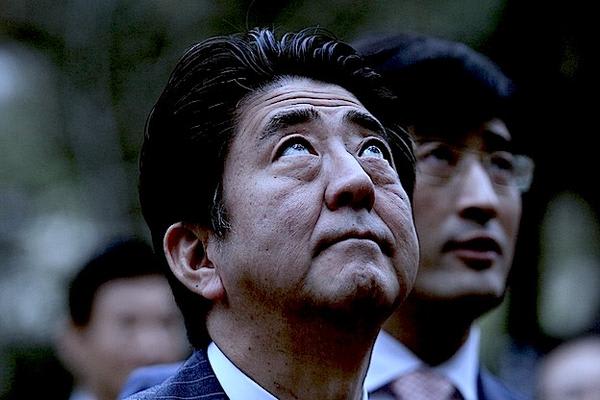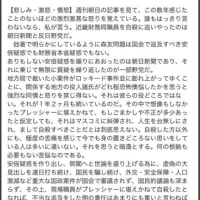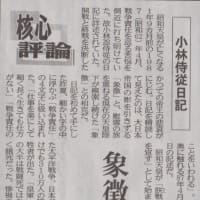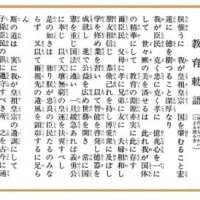河信基@hashingi さんのツイート。
――安倍首相は拉致問題を安保法制整備に利用することしか考えていない。こじれた方が好都合と考えている。
なぜ進展ない 拉致家族ら怒り - Y!ニュース (2015年5月28日(木)掲載) http://news.yahoo.co.jp/pickup/6161599 #北朝鮮日本人拉致事件〔6:37 - 2015年5月29日 〕――
タイム誌には、
KAKAPO➤endangered @178kakapoさんによると、
――「安倍首相の経済政策は失敗、もう手遅れ…
彼は、まだ必要なことを何も行っていない。
…それは、首相が無為に2年間を過ごしたたことを意味する」〔22:51 - 2014年11月17日 〕――
との批判があるらしい。
残念ながら、その通りかもしれない。
ただ、安倍某は、
アベノミクスについてなど、
根本的な政治的判断がずれている。
だから妙な
言論統制をしようとするのだ。
たとえば、
上掲ツイートに
リンクされたサイトに移動しようとすると、
「このサイトは、危険です」
の表示が出る。
言論統制するつもりなのか――。
そういうやり口を見るにつけ、
このニュース・サイトの切り口が大変、優れている
との心証を得る。
参考までに、
読まれたらいいだろう。
安倍某がいかに
「株価高騰→政権が安泰」
という妄想に憑りつかれているかが分る。
思うに、この評価は、
決定的に誤っていると言うべきだ。
いくら、
庶民が愚かとしても、
株価が高値で維持されていることと、
景気回復を
結び付けて考えるおっちょこちょいはいないだろう。
それは、
マスコミの煽りに過ぎないこと、
とっくの昔に
見抜かれていると見て
間違いない。
〔資料〕
「「なぜ進展しないのか」=拉致家族ら、不安と怒り―日朝合意発表1年」
時事通信 (5月28日(木)14時47分配信)
☆ 記事URL:http://headlines.yahoo.co.jp/hl?a=20150528-00000084-jij-soci
北朝鮮が日本人拉致被害者らの再調査を行うと約束した「ストックホルム合意」の発表から29日で1年。再調査に関し具体的な動きが見られない中、拉致被害者や特定失踪者の家族は28日、「なぜ進展しないのか」「何年もこういうことの繰り返しだ」と口々に不安や怒りを訴えた。
再調査を「千載一遇のチャンス」と歓迎していた拉致被害者家族会の飯塚繁雄代表(76)は「あれから1年もたつが、具体的な解決の兆しが全く見えないことに怒りを感じる」と憤る。「われわれが求めているのは調査結果の報告書ではなく、被害者の奪還だ。一刻も早く具体的な解決策を示し、被害者を返せと言いたい」と強調した。
横田めぐみさん=失踪当時(13)=の母早紀江さん(79)は「あの国はもう何年もこういうことの繰り返し。去年も半分は期待したけれど、もう半分は『そう簡単にいくのかな』と思っていた」とため息。「自分の子どもと再会できず亡くなるほどむごいことはない。政府には、被害者が今も助けを待っていることを忘れないで交渉に当たってほしい」と求めた。
〔資料ー2〕
「It May Be Too Late for Japan’s PM to Fix the World’s Third Largest Economy」
TIME(Nov. 14, 2014)Michael Schuman @MichaelSchuman
☆ 記事URL:http://time.com/3584926/japan-economy-abenomics-shinzo-abe-liberal-democratic-party-ldp/
Shinzo Abe is desperate to rescue his failing economic program, but he still hasn't done what's necessary

Tokyo is abuzz with speculation that Prime Minister Shinzo Abe is about to dissolve the Diet, as the country’s legislature is known, and call a snap election.
He by no means has to take such action. It has only been two years since his Liberal Democratic Party, or LDP, swept to power in a massive landslide, and the opposition is in such disarray that there is little doubt Abe would be returned to office in a new election. Nevertheless, Abe apparently feels the need for another vote of confidence from the public, likely in part to bolster support for his radical program to revive Japan’s economy, nicknamed Abenomics.
The problem is that it could already be too late. Abenomics is a failure, and Abe isn’t likely to fix it, no matter how many seats his party holds in parliament.
When Abe first introduced Abenomics, many economists — most notably, Nobel laureate Paul Krugman — believed the unconventional program would finally end the economy’s two-decade slump. The plan: the Bank of Japan (BOJ), the country’s
central bank, would churn out yen on a biblical scale to smash through the economy’s endemic and destructive cycle of deflation, while Abe’s government would pump up fiscal spending and implement long-overdue reforms to the structure of the economy. Advocates argued that Abenomics was just the sort of bold action to jump-start growth and fix a broken Japan, and we all had reason to hope that it would work. Japan is still the world’s third largest economy, and a revival there would add another much-needed pillar to hold up sagging global economic growth.
However, I had my concerns from the very beginning. In my view, Japan’s economy doesn’t grow because there is a lack of demand. Pumping more cash into the economy, therefore, will not restart growth. Only deep reform to raise the potential of the economy can do that — by improving productivity and unleashing new economic energies. Unless Abe changed the way Japan’s economy works — and I doubted he would — all of the largesse from the BOJ would at best come to nothing. In a worst-case scenario, Abe’s program could turn Japan into an even bigger economic mess than it already is.
So far, Abenomics has disappointed. GDP shrank a hope-dashing annualized 7.1% in the quarter ending June. Inflation, meanwhile, is nowhere near the BOJ target of 2%, and is slowing. Nor has Abenomics brought significant benefits to the general populace. Job creation and wage increases are sluggish and, with prices increases, the welfare of the average salaried worker has suffered. Meanwhile, an increase in consumption tax earlier this year — made necessary by the need to shore up the government’s shaky finances — further burdened Japanese households and led to a drastic decline in consumer spending.
The response of policymakers has been to double down on Abenomics. On Oct. 31, the BOJ surprised markets by greatly expanding its unorthodox stimulus program, known as quantitative easing, or QE. As part of that, the BOJ will increase its annual purchases of Japanese government bonds by 60% to a staggering $700 billion. More of the same, however, will just have the same result: a short-term boost to sentiment with little lasting effect. In fact, the program is only perpetuating Japan’s bad habits. The extra BOJ cash is weakening the yen — the Japanese currency has tumbled by nearly 7% against the dollar just since the bank’s announcement
— which hands Japan Inc. companies more competitiveness without forcing them to undertake any actual improvements.
The problem with Abenomics, therefore, remains the same. More yen printed by the BOJ can’t fix Japan on its own, and can’t replace the fundamental changes necessary to raise the economy’s potential growth. If anything, the BOJ’s latest action only buys Abe a bit more time to implement his pledged reform program, known at the “third arrow” of Abenomics.
So far, though, the third arrow has remained in his quiver. In June, Abe unveiled the latest elements of the plan, which included everything from lowering the corporate-tax rate to spur investment, to enlisting more women into the male-dominated workforce, and bringing further change to an unproductive and outdated agricultural sector. It would be unfair to say that Abe has made no progress on his promises. The number of working women, for instance, has been on the rise under his administration. But many important reforms remain stalled. Abe had announced the formation of “special economic zones,” which would be crucibles of experimentation with the deep deregulation necessary to spark entrepreneurship and investment, but their implementation has
crept along at a glacial pace. Serious reform of the country’s distorted labor market seems to have slipped off the table. Abe is also foot-dragging on opening the economy to more competition by holding up the completion of the U.S.-sponsored Trans-Pacific Partnership free-trade pact over an unwillingness to expose Japan’s overly protected farmers to imports.
The big question is whether another election will somehow lead to faster reform. In theory, a fresh mandate could give Abe the added political clout he needs to press ahead more boldly. However, Abe
already controls both houses of the Diet, so if he wanted to move more quickly on reform, he could. That has left some analysts wondering what difference an election may make. “A snap election could have the virtue of giving the government a stronger mandate as it struggles to push ahead with structural reform,” commented Mark Williams and Marcel Thieliant of research outfit Capital Economics. But since Abe’s party has already been in a strong position, “an election would not make much practical difference to his ability to get things done.”
Abe continues to insist he is a reformer and will follow through on his grand pronouncements. “Make no mistake, Japan will emerge from economic contraction and advance into new fields and engage in fresh challenges,” Abe recently wrote in the Wall Street Journal. “There is no reason for alarm.”
Alarm bells should be ringing in Tokyo, however. Even if Abe gets the “third arrow” in the air, it could still miss its target. Many of the reforms Japan needs will take years to implement. Meanwhile, the other two arrows of Abenomics may already be running their course.
There was opposition within the BOJ to its latest decision to boost QE — an indication that the bank can’t be counted upon to keep the printing presses rolling forever. Nor can Abe dodge the need to stabilize the government’s debt and deficits indefinitely. The government’s debt is 240% of the country’s GDP — the largest among major advanced economies. He’s right now weighing whether or not to hike the consumption tax yet again. Imposing it could deal another blow to growth; postponing it would undermine what little credibility Abe had as a fixer of the nation’s finances.
In the end, repairing Japan requires more political will than Abe has shown. Maybe a new election will help him find it. But don’t hold your breath.
(※以下、サイト「★阿修羅♪>」に掲載されていたTIME記事の翻訳文を紹介します。)
安倍晋三は、彼の失敗経済計画(アベノミクス)のリカバリーのために必死です。
実際に必要な手立を何も行っていません。
さらに解散総選挙を宣言したことで、国会や各政党は憶測などが飛び交わって、騒然としています。
彼の所属する自民党が与党となり2年が経ちました。
ただ、11月16日に行われた沖縄県知事選挙も対立候補が当選するなど、与党自民党への大衆の支持が下がっていることは明白です。
野党は、安倍が公職選挙上で疑いがあるような議案を提出し、国会が混乱しています。
その最中にもかかわらず、安倍はアベノミクス(日本経済復活プログラム)を強化するために、
解散総選挙を選んだというのが大方の見方である。
しかし問題は、アベノミクスは失敗であり、既に手遅れであるということだ。
アベノミクスのリカバリーには、議員数や議案数など全く関係ないのだ。
安倍が最初に、アベノミクスを導入したとき、多くのエコノミストは(例えばノーベル賞受賞者ポール・クルーグマンは )
この型破りなプログラムは、最終的に経済の二十年の不況を終わらせるだろうとを信じていた。
しかし、私は最初から懸念を持っていた。
アベノミクスの戦略で、経済に多くの現金を注入しても、内部需要が不足し潜在能力の向上を期待できないことだ。
そして、いまのまま続けていても、日本経済の成長は見込めないのだ。
日本は依然として世界第三位の経済大国である。そのためにのも復活は必要である。
それには、真っ先に行なわなければならない緊急の改革は、潜在能力を高めることだ。
例えば、生産性の向上や新たな経済エネルギーを解き放つなどし、経済の仕組みを全く変えない限り、経済成長は 難しい。
解散総選挙の結果次第では、アベノミクスが継続、あるいは中断されると思われる。
しかし、日本経済の潜在力が高まらない限り、さらに深刻な経済的混乱を招く可能性もある。
――安倍首相は拉致問題を安保法制整備に利用することしか考えていない。こじれた方が好都合と考えている。
なぜ進展ない 拉致家族ら怒り - Y!ニュース (2015年5月28日(木)掲載) http://news.yahoo.co.jp/pickup/6161599 #北朝鮮日本人拉致事件〔6:37 - 2015年5月29日 〕――
タイム誌には、
KAKAPO➤endangered @178kakapoさんによると、
――「安倍首相の経済政策は失敗、もう手遅れ…
彼は、まだ必要なことを何も行っていない。
…それは、首相が無為に2年間を過ごしたたことを意味する」〔22:51 - 2014年11月17日 〕――
との批判があるらしい。
残念ながら、その通りかもしれない。
ただ、安倍某は、
アベノミクスについてなど、
根本的な政治的判断がずれている。
だから妙な
言論統制をしようとするのだ。
たとえば、
上掲ツイートに
リンクされたサイトに移動しようとすると、
「このサイトは、危険です」
の表示が出る。
言論統制するつもりなのか――。
そういうやり口を見るにつけ、
このニュース・サイトの切り口が大変、優れている
との心証を得る。
参考までに、
読まれたらいいだろう。
安倍某がいかに
「株価高騰→政権が安泰」
という妄想に憑りつかれているかが分る。
思うに、この評価は、
決定的に誤っていると言うべきだ。
いくら、
庶民が愚かとしても、
株価が高値で維持されていることと、
景気回復を
結び付けて考えるおっちょこちょいはいないだろう。
それは、
マスコミの煽りに過ぎないこと、
とっくの昔に
見抜かれていると見て
間違いない。
〔資料〕
「「なぜ進展しないのか」=拉致家族ら、不安と怒り―日朝合意発表1年」
時事通信 (5月28日(木)14時47分配信)
☆ 記事URL:http://headlines.yahoo.co.jp/hl?a=20150528-00000084-jij-soci
北朝鮮が日本人拉致被害者らの再調査を行うと約束した「ストックホルム合意」の発表から29日で1年。再調査に関し具体的な動きが見られない中、拉致被害者や特定失踪者の家族は28日、「なぜ進展しないのか」「何年もこういうことの繰り返しだ」と口々に不安や怒りを訴えた。
再調査を「千載一遇のチャンス」と歓迎していた拉致被害者家族会の飯塚繁雄代表(76)は「あれから1年もたつが、具体的な解決の兆しが全く見えないことに怒りを感じる」と憤る。「われわれが求めているのは調査結果の報告書ではなく、被害者の奪還だ。一刻も早く具体的な解決策を示し、被害者を返せと言いたい」と強調した。
横田めぐみさん=失踪当時(13)=の母早紀江さん(79)は「あの国はもう何年もこういうことの繰り返し。去年も半分は期待したけれど、もう半分は『そう簡単にいくのかな』と思っていた」とため息。「自分の子どもと再会できず亡くなるほどむごいことはない。政府には、被害者が今も助けを待っていることを忘れないで交渉に当たってほしい」と求めた。
〔資料ー2〕
「It May Be Too Late for Japan’s PM to Fix the World’s Third Largest Economy」
TIME(Nov. 14, 2014)Michael Schuman @MichaelSchuman
☆ 記事URL:http://time.com/3584926/japan-economy-abenomics-shinzo-abe-liberal-democratic-party-ldp/
Shinzo Abe is desperate to rescue his failing economic program, but he still hasn't done what's necessary

Tokyo is abuzz with speculation that Prime Minister Shinzo Abe is about to dissolve the Diet, as the country’s legislature is known, and call a snap election.
He by no means has to take such action. It has only been two years since his Liberal Democratic Party, or LDP, swept to power in a massive landslide, and the opposition is in such disarray that there is little doubt Abe would be returned to office in a new election. Nevertheless, Abe apparently feels the need for another vote of confidence from the public, likely in part to bolster support for his radical program to revive Japan’s economy, nicknamed Abenomics.
The problem is that it could already be too late. Abenomics is a failure, and Abe isn’t likely to fix it, no matter how many seats his party holds in parliament.
When Abe first introduced Abenomics, many economists — most notably, Nobel laureate Paul Krugman — believed the unconventional program would finally end the economy’s two-decade slump. The plan: the Bank of Japan (BOJ), the country’s
central bank, would churn out yen on a biblical scale to smash through the economy’s endemic and destructive cycle of deflation, while Abe’s government would pump up fiscal spending and implement long-overdue reforms to the structure of the economy. Advocates argued that Abenomics was just the sort of bold action to jump-start growth and fix a broken Japan, and we all had reason to hope that it would work. Japan is still the world’s third largest economy, and a revival there would add another much-needed pillar to hold up sagging global economic growth.
However, I had my concerns from the very beginning. In my view, Japan’s economy doesn’t grow because there is a lack of demand. Pumping more cash into the economy, therefore, will not restart growth. Only deep reform to raise the potential of the economy can do that — by improving productivity and unleashing new economic energies. Unless Abe changed the way Japan’s economy works — and I doubted he would — all of the largesse from the BOJ would at best come to nothing. In a worst-case scenario, Abe’s program could turn Japan into an even bigger economic mess than it already is.
So far, Abenomics has disappointed. GDP shrank a hope-dashing annualized 7.1% in the quarter ending June. Inflation, meanwhile, is nowhere near the BOJ target of 2%, and is slowing. Nor has Abenomics brought significant benefits to the general populace. Job creation and wage increases are sluggish and, with prices increases, the welfare of the average salaried worker has suffered. Meanwhile, an increase in consumption tax earlier this year — made necessary by the need to shore up the government’s shaky finances — further burdened Japanese households and led to a drastic decline in consumer spending.
The response of policymakers has been to double down on Abenomics. On Oct. 31, the BOJ surprised markets by greatly expanding its unorthodox stimulus program, known as quantitative easing, or QE. As part of that, the BOJ will increase its annual purchases of Japanese government bonds by 60% to a staggering $700 billion. More of the same, however, will just have the same result: a short-term boost to sentiment with little lasting effect. In fact, the program is only perpetuating Japan’s bad habits. The extra BOJ cash is weakening the yen — the Japanese currency has tumbled by nearly 7% against the dollar just since the bank’s announcement
— which hands Japan Inc. companies more competitiveness without forcing them to undertake any actual improvements.
The problem with Abenomics, therefore, remains the same. More yen printed by the BOJ can’t fix Japan on its own, and can’t replace the fundamental changes necessary to raise the economy’s potential growth. If anything, the BOJ’s latest action only buys Abe a bit more time to implement his pledged reform program, known at the “third arrow” of Abenomics.
So far, though, the third arrow has remained in his quiver. In June, Abe unveiled the latest elements of the plan, which included everything from lowering the corporate-tax rate to spur investment, to enlisting more women into the male-dominated workforce, and bringing further change to an unproductive and outdated agricultural sector. It would be unfair to say that Abe has made no progress on his promises. The number of working women, for instance, has been on the rise under his administration. But many important reforms remain stalled. Abe had announced the formation of “special economic zones,” which would be crucibles of experimentation with the deep deregulation necessary to spark entrepreneurship and investment, but their implementation has
crept along at a glacial pace. Serious reform of the country’s distorted labor market seems to have slipped off the table. Abe is also foot-dragging on opening the economy to more competition by holding up the completion of the U.S.-sponsored Trans-Pacific Partnership free-trade pact over an unwillingness to expose Japan’s overly protected farmers to imports.
The big question is whether another election will somehow lead to faster reform. In theory, a fresh mandate could give Abe the added political clout he needs to press ahead more boldly. However, Abe
already controls both houses of the Diet, so if he wanted to move more quickly on reform, he could. That has left some analysts wondering what difference an election may make. “A snap election could have the virtue of giving the government a stronger mandate as it struggles to push ahead with structural reform,” commented Mark Williams and Marcel Thieliant of research outfit Capital Economics. But since Abe’s party has already been in a strong position, “an election would not make much practical difference to his ability to get things done.”
Abe continues to insist he is a reformer and will follow through on his grand pronouncements. “Make no mistake, Japan will emerge from economic contraction and advance into new fields and engage in fresh challenges,” Abe recently wrote in the Wall Street Journal. “There is no reason for alarm.”
Alarm bells should be ringing in Tokyo, however. Even if Abe gets the “third arrow” in the air, it could still miss its target. Many of the reforms Japan needs will take years to implement. Meanwhile, the other two arrows of Abenomics may already be running their course.
There was opposition within the BOJ to its latest decision to boost QE — an indication that the bank can’t be counted upon to keep the printing presses rolling forever. Nor can Abe dodge the need to stabilize the government’s debt and deficits indefinitely. The government’s debt is 240% of the country’s GDP — the largest among major advanced economies. He’s right now weighing whether or not to hike the consumption tax yet again. Imposing it could deal another blow to growth; postponing it would undermine what little credibility Abe had as a fixer of the nation’s finances.
In the end, repairing Japan requires more political will than Abe has shown. Maybe a new election will help him find it. But don’t hold your breath.
(※以下、サイト「★阿修羅♪>」に掲載されていたTIME記事の翻訳文を紹介します。)
安倍晋三は、彼の失敗経済計画(アベノミクス)のリカバリーのために必死です。
実際に必要な手立を何も行っていません。
さらに解散総選挙を宣言したことで、国会や各政党は憶測などが飛び交わって、騒然としています。
彼の所属する自民党が与党となり2年が経ちました。
ただ、11月16日に行われた沖縄県知事選挙も対立候補が当選するなど、与党自民党への大衆の支持が下がっていることは明白です。
野党は、安倍が公職選挙上で疑いがあるような議案を提出し、国会が混乱しています。
その最中にもかかわらず、安倍はアベノミクス(日本経済復活プログラム)を強化するために、
解散総選挙を選んだというのが大方の見方である。
しかし問題は、アベノミクスは失敗であり、既に手遅れであるということだ。
アベノミクスのリカバリーには、議員数や議案数など全く関係ないのだ。
安倍が最初に、アベノミクスを導入したとき、多くのエコノミストは(例えばノーベル賞受賞者ポール・クルーグマンは )
この型破りなプログラムは、最終的に経済の二十年の不況を終わらせるだろうとを信じていた。
しかし、私は最初から懸念を持っていた。
アベノミクスの戦略で、経済に多くの現金を注入しても、内部需要が不足し潜在能力の向上を期待できないことだ。
そして、いまのまま続けていても、日本経済の成長は見込めないのだ。
日本は依然として世界第三位の経済大国である。そのためにのも復活は必要である。
それには、真っ先に行なわなければならない緊急の改革は、潜在能力を高めることだ。
例えば、生産性の向上や新たな経済エネルギーを解き放つなどし、経済の仕組みを全く変えない限り、経済成長は 難しい。
解散総選挙の結果次第では、アベノミクスが継続、あるいは中断されると思われる。
しかし、日本経済の潜在力が高まらない限り、さらに深刻な経済的混乱を招く可能性もある。




















※コメント投稿者のブログIDはブログ作成者のみに通知されます